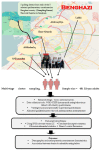Investigating the Association between Unhealthy Dietary Habits and Obesity among Libyan Adults
- PMID: 35162100
- PMCID: PMC8834426
- DOI: 10.3390/ijerph19031076
Investigating the Association between Unhealthy Dietary Habits and Obesity among Libyan Adults
Abstract
Although an increasing number of studies have reported on nutrition transition and unhealthy eating habits (UEHs) worldwide, there is a paucity of studies on UEHs in the Arab region, particularly in Libya. Aim: This study investigated the associations between obesity among Libyan adults and UEHs. Methods: A cross-sectional survey was conducted at the five major districts in Benghazi, Libya. A multistage cluster sampling strategy was implemented to choose and recruit Libyan adults. Anthropometric measurements were gathered by highly qualified nurses, using the Segmental Body Composition Monitor and a portable Stadiometer. The study used and adapted the two Self-administered questionnaires: the WHO STEPS Instrument and eating behaviors linked with obesity questionnaire. Results: Among a total of 401 participants who were successfully recruited in this study, 253 (63%) were female (aged 20-65 years), the response rate achieved was 78%. The prevalence of obesity amongst Libyan adults was estimated to be 42.4%. The results revealed the presence of a significant association between obesity (BMI ≥ 30 kg/m2) and five UEHs for Libyan men and six UEHs for Libyan women. For Libyan men, an association was found between obesity and the following five explanatory factors: fast food intake in a day and a week, which were (OR: 2.52, 95% CI: 4.04-12.32) and (OR: 4.65, 95% CI: 1.04-9.46), respectively; large food portion sizes consumed at one sitting (OR: 19.54, 95% CI: 1.41-27.74); a high frequency of skipping breakfast either in a typical day or a week, which were (OR: 0.02, 95% CI: 0.01-0.77) and (OR: 0.03, 95% CI: 0.01-0.24), respectively. For Libyan women, a significant association was found between obesity and the following six explanatory factors: fast food intake in a day and a week, which were (OR: 2.14, 95% CI: 3.32-11.12) and (OR: 5.5, 95% CI: 1.88-16.11), respectively; intake of sugar-sweetened beverages in a typical week (OR: 4.02, 95% CI: 1.35-11.99); and large food portion sizes consumed at one sitting at one sitting (OR: 3.40, 95% CI: 1.18-9.84); and a high frequency of skipping breakfast either in a typical day or a week, which were (OR: 0.11, 95% CI: 0.03-0.43) and (OR: 0.12, 95% CI: 0.08-0.63), respectively. Conclusions: The findings of the study reveal areas of action for Libyan researchers, clinicians, policymakers, and government officials about UEHs in the Libyan context. This could inform establishing and developing new interventions for preventing and controlling the obesity epidemic through food system improvements.
Keywords: BMI; Libya; eating behavior; eating habits; food portion sizes; obesity; skipping breakfast.
Conflict of interest statement
Authors have no conflict of interest to declare.
Figures
Similar articles
-
Prevalence of Overweight and Obesity among Libyan Men and Women.Biomed Res Int. 2019 Jul 15;2019:8531360. doi: 10.1155/2019/8531360. eCollection 2019. Biomed Res Int. 2019. PMID: 31392214 Free PMC article. Clinical Trial.
-
Perceived Environmental Factors Associated with Obesity in Libyan Men and Women.Int J Environ Res Public Health. 2018 Feb 9;15(2):301. doi: 10.3390/ijerph15020301. Int J Environ Res Public Health. 2018. PMID: 29425161 Free PMC article.
-
Dietary behaviors, physical activity and sedentary lifestyle associated with overweight and obesity, and their socio-demographic correlates, among Pakistani primary school children.Int J Behav Nutr Phys Act. 2011 Nov 25;8:130. doi: 10.1186/1479-5868-8-130. Int J Behav Nutr Phys Act. 2011. PMID: 22117626 Free PMC article.
-
[Simple obesity in children. A study on the role of nutritional factors].Med Wieku Rozwoj. 2006 Jan-Mar;10(1):3-191. Med Wieku Rozwoj. 2006. PMID: 16733288 Review. Polish.
-
Association between Breakfast Skipping and Body Weight-A Systematic Review and Meta-Analysis of Observational Longitudinal Studies.Nutrients. 2021 Jan 19;13(1):272. doi: 10.3390/nu13010272. Nutrients. 2021. PMID: 33477881 Free PMC article.
Cited by
-
Burden of cardiometabolic disease attributable to sugar sweetened beverages consumption in North Africa and the Middle East from 1990 to 2021.J Diabetes Metab Disord. 2025 Feb 12;24(1):66. doi: 10.1007/s40200-025-01578-9. eCollection 2025 Jun. J Diabetes Metab Disord. 2025. PMID: 39959579
-
A Hybrid MCDM Approach Based on Fuzzy-Logic and DEMATEL to Evaluate Adult Obesity.Int J Environ Res Public Health. 2022 Nov 22;19(23):15432. doi: 10.3390/ijerph192315432. Int J Environ Res Public Health. 2022. PMID: 36497509 Free PMC article.
References
-
- NCD Risk Factor Collaboration (NCD-RisC) Height and Body-Mass Index Trajectories of School-Aged Children and Adolescents from 1985 to 2019 in 200 Countries and Territories: A Pooled Analysis of 2181 Population-Based Studies with 65 Million Participants. Lancet. 2020;396:1511–1524. doi: 10.1016/S0140-6736(20)31859-6. - DOI - PMC - PubMed
-
- World Health Organisation (WHO) Obesity and Overweight Fact Sheet No. 311. 2021. [(accessed on 8 August 2021)]. Available online: https://www.who.int/news-room/fact-sheets/detail/obesity-and-overweight/
-
- Lemamsha H. Ph.D. Thesis. University of Bedfordshire; Luton, UK: 2016. [(accessed on 5 October 2021)]. Exploring the Risk and Protective Factors Associated with Obesity Amongst Libyan Adults (20–65 years) Available online: https://core.ac.uk/download/pdf/77037983.pdf.
Publication types
MeSH terms
LinkOut - more resources
Full Text Sources
Medical


